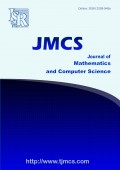Cutting-plane Algorithm for Solving Linear Semi-infinite Programming in Fuzzy Case
-
2360
Downloads
-
3581
Views
Authors
Alireza Fakharzadeh
- Department of Mathematics, Shiraz University of Technology.
Somayeh Khosravi
- Department of Mathematics, Shiraz University of Technology.
Hamidreza Maleki
- Department of Mathematics, Shiraz University of Technology.
Abstract
This paper introduces a cutting-plane algorithm for solving semi-infinite linear programming problems in fuzzy case; the problem contains a crisp objective linear function and the infinite number of fuzzy linear constraints. In the first step; the designed algorithm solves a LP problem, which was created by the ranking function method based on a fuzzy sub-problem of the original one. In each iteration of the proposed algorithm, a cutting is created by adding a fuzzy constraint of the original problem to the fuzzy sub-problem. The convergence of the algorithm is proved and some numerical examples are given.
Share and Cite
ISRP Style
Alireza Fakharzadeh, Somayeh Khosravi, Hamidreza Maleki, Cutting-plane Algorithm for Solving Linear Semi-infinite Programming in Fuzzy Case , Journal of Mathematics and Computer Science, 5 (2012), no. 3, 212 - 218
AMA Style
Fakharzadeh Alireza, Khosravi Somayeh, Maleki Hamidreza, Cutting-plane Algorithm for Solving Linear Semi-infinite Programming in Fuzzy Case . J Math Comput SCI-JM. (2012); 5(3):212 - 218
Chicago/Turabian Style
Fakharzadeh, Alireza, Khosravi, Somayeh, Maleki, Hamidreza. "Cutting-plane Algorithm for Solving Linear Semi-infinite Programming in Fuzzy Case ." Journal of Mathematics and Computer Science, 5, no. 3 (2012): 212 - 218
Keywords
- Semi-infinite linear programming
- Cutting-plane
- Fuzzy linear programming.
MSC
References
-
[1]
R. E. Bellman, L. A. Zadeh, Decision making in a fuzzy environment, Management Science, 17 (1970), 141-164.
-
[2]
B. Betro, An accelerated centeral cutting plane, Math. Program, 101 (2004), 479-495.
-
[3]
B. Betro, Numerical treatment of Bayesian robustness problems, International Journal of Approximate Reasoning, 50 (2009), 279-288.
-
[4]
M. A. Goberna, M. A. Lopez, Linear Semi Infinite Programming, Alicant University, (1998)
-
[5]
A. Ismael, F. Vaz, C. Eugnio Ferreira, Air pollution control with semi-infinite programming, Applied Mathematical Modelling, 33 (2009), 1957-1969.
-
[6]
A. Ismael, F. Vaz, Edite M. G. P. Fernandes, M. Paula, S. F. Gomes , Robot trajectory planning with semi-infinite programming, European Journal of Operational Research, 153 (2004), 607-617.
-
[7]
K. Glashoff, S. A. Gustafson, Linear Optimization and Approximation, Springer-Verlag, Berlin (1983)
-
[8]
He. Li, Huang, H. Guo, Lu. Hongwei, Bivariate interval semi-infinite programming with an application to environmental decision-making analysis, European Journal of Operational Research, 211 (2011), 452-465.
-
[9]
T. Leon, E. Vercher , A purification algorithm for semi-infinite programming, European Journal of Operational Research, 57 (1992), 412-420.
-
[10]
H. R. Maleki, Ranking function and their applications to fuzzy linear programming, Far East J. Math. Sci (EFMS), 4 (2002), 283-301.
-
[11]
P. Moulin, M. Anitescu, K. O. Kortanek, F. A. Potra, The role of linear semi-infinite programming in signal-adapted QMF bank design, IEEE Trans. Signal Processing, 45 (1997), 2160-2174.
-
[12]
M. Roubnes, Inequality constraints between fuzzy number and their use in mathematical programming Stochastic Versus Fuzzy Approaches To Multi objective Mathematical Programming Under Uncertainly, Kluwer Academic Publishers, (1991), 321-330.
-
[13]
L. A. Zadeh, Fuzzy sets, Information and Control, 8 (1965), 338-353.

